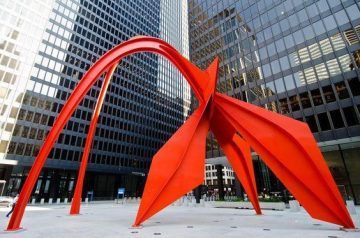From The Easel:
 Morgan Meis: Reading your second volume, I got a feeling that sometimes you struggled – as I think everyone has struggled – with where to place Calder in art history. Do you feel you reached a conclusion on that?
Morgan Meis: Reading your second volume, I got a feeling that sometimes you struggled – as I think everyone has struggled – with where to place Calder in art history. Do you feel you reached a conclusion on that?
Jed Perl: Calder isn’t easy to place. Ultimately that’s the measure of his greatness. Many people have struggled with the question of Calder’s relationship with Surrealism. Calder and some close friends, like Miró and Masson, all insisted that they were at odds with Surrealism. What was important for them, and certainly for Calder, was being in an atmosphere and ambience of ideas, theories and experiments — people doing this or that. Calder, like Miró and Masson, was nourished by the Surrealist environment; sometimes, they contributed to it, at other times they opposed it. There was a complex and dynamic process going on. Neither Miró, Masson nor Calder wanted to be pinned down or labelled by André Breton, the ringleader of the Surrealists. Geniuses are nurtured in very mysterious ways. There are so many influences that were more important to Calder than whatever he absorbed from the Surrealists. Calder was deeply influenced by Bosch’s great triptych, The Garden of Earthly Delights. He was immensely interested in architecture and architectural forms, both ancient and modern.
More here.
